Making Feta Cheese at Home
Back in January, when DCCC was deep into Greek cooking, my boyfriend, Mike, who is always challenging me to think outside the box, and to take things one step further, suggested I make homemade feta cheese. Because of my zeal for exhaustive research, I sometimes wonder if he later regrets these, at the time, casually made suggestions. After having made four test batches, the refrigerator is full of multiple containers of feta marked “Test 1,” “Test 2,” and so on. If it weren’t for the fact that feta keeps a very long time in brine—up to a year—I would worry how just the two of us would be able consume so much of it. Now, after allowing all the batches of homemade feta cheese a full four weeks to cure in brine, I’m ready to report my findings to you.
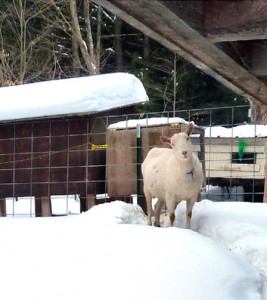
"Creamy," an Alpine-Saanen mix, owned by goat herder Martha Haffner. I love the quizzical look that goat's have.
Living in rural Vermont—a state known for cheese and dairy production—we have fairly easy access to farm fresh goat’s milk, so I made three batches with goat’s milk and one with cow’s milk. Sheep’s milk, the most traditional milk for making feta, is much harder to find where I live.
In addition to using two different milks, I tried two different cultures (sometimes called “starters”)—a basic mesophilic and a feta culture; lipase powder, a water-soluble enzyme added to milk to create stronger flavor in some cheeses; and calcium chloride, used to create a firmer curd.
All of the versions turned out—meaning, they all turned into cheese that looked, tasted, and behaved like feta, though some more than others. Ultimately, the decision of what culture to use, what milk, and whether to use lipase is one of personal taste. I’ll try to objectively describe my own preferences so that you can decide which version you might like to try first.
Like all types of agricultural products, cheesemaking is affected by the seasons. Though there are other variables, the single biggest impact on the flavor of cheese is the feed the animals are on, which is, in turn related to the time of year (dried grains in winter; fresh pasture in summer). According to Mary Jane Toth, author of Goats Produce Too!, lipase is more noticeable in milk during the winter months when goats stock are on dry feed or are near the end of lactation. (Most goat herders “dry off” their herd—meaning, stop milking them to give them a rest before spring birthing—mid-winter.) I suggest starting with a small batch, adjust with lipase if you like a stronger flavor, and add calcium chloride if the curd isn’t holding its shape after a week or so in brine.
A Cheese Tasting
We did two tastings: once after all of the batches had aged in brine for at least one week, and then again after 4 weeks. Honestly, the flavor seemed about the same—slightly more developed, yes; however, the saltiness was noticeably stronger.
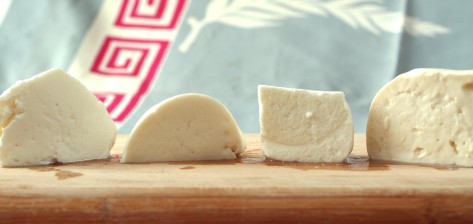
Four batches of feta (From the left: goat's milk with mesophilic and feta cultures, one with lipase and one without, and the final with cow's milk and lipase)
My favorite was the version made with goat’s milk and the feta culture. In comparison to the goat’s milk batch made with the mesophilic culture, the flavor is both more complex and sharper, having more of the classic “feta” flavor, and the texture is a bit drier and slightly crumbly, like that of traditional feta. The batch made with meophilic culture has a creamy texture and milder flavor that is also delicious, but a little one-dimensional by contrast. I found that it does not hold up as well in brine, even after being salted and drained for a couple of days, as the batch made with the feta culture, and so it should be used more quickly.
Of the two versions made with lipase powder, both with the feta culture, I liked the cow’s milk version much better. When making feta with the milder cow’s milk, recipes often call for lipase powder to better approximate the flavor of traditional feta made with sheep or goat’s milk. This was accomplished, although the flavor and texture was not as classic as that achieved using goat’s milk. But it is good, and is worth doing, particularly if you do not have access to goat or sheep’s milk. As an experiment, I also added calcium chloride to the batch with cow’s milk, and it definitely created a firm curd that has held up well in brine.
I found the flavor of the batch made with goat’s milk and lipase was overpowering and one-dimensional, and it had an unpleasant aftertaste. I couldn’t help but think that this must be the flavor that the feta-adverse associate with the cheese. It may be that because goat’s milk naturally has a fair amount lipase, and the goat’s were on winter feed and close to drying off (when the lipase enzyme is highest), adding lipase powder was overkill, especially in combination with the feta culture which provides more flavor than the mesophilic culture. In defense of this version, Mike it well enough, so if you like very strong flavors, you might enjoy it.
The Method
For starters, I read Ricki Carroll’s recipe in the third edition of her book Home Cheesemaking, but found it lacking sufficient explanation and detail. Looking further, I found that recipes ranged from the very simple to complex. I came up with a more detailed version of Ricki Carroll’s simple method after posing a few questions to Karen Bixler, a local cheesemaker; Leslie Mann, the Cheese Manager at Bob-White Systems in nearby South Royalton; Egon Skovmose at Danlac, a cheese and yogurt supply company for professional cheesemakers and a distributor of the feta cheese culture I used; and referencing the feta-making instructions in an Aug/Sept 2009 issue of Fine Cooking, Mary Jane Toth’s book Goats Produce Too!, and the sites CheeseForum.org and Cheesemaking.com. Egon at Danlac was particularly helpful, sharing several tips with me, including the 12% saline solution that I use in the brine. If you need some immediate trouble-shooting guidance from experts, I recommend visiting both CheeseForum.org and Cheesemaking.com.
Simple Feta Cheese
(Adapted from Ricki Carroll’s recipe in Home Cheesemaking)
This recipe can be used with cow’s milk or the more traditional goat’s or sheep’s milk. I haven’t tried it with sheep’s milk, but, according to Diane Kochilas, author of The Food and Wine of Greece, goat’s milk produces a more piquant feta cheese than sheep’s milk. When making cheese, use stainless-steel pots and utensils, and be sure to sanitize everything before beginning.
Makes 1¼ to 1½ pounds
1 gallon whole milk
¼ teaspoon calcium chloride solution (if using store-bought pasteurized milk)
¼ teaspoon mild lipase powder diluted in ¼ cup unchlorinated water and allowed to sit for 15 minutes (optional, but recommended for cow’s milk feta, particularly if using the mesophilic culture)
½ teaspoon direct-set feta A (or B) culture or 1 packet (1 heaping ¼ teaspoon) direct-set mesophilic culture
½ plus ⅛ teaspoon liquid rennet diluted in ¼ cup cool, unchlorinated water
Non-idodized salt, such as cheese, kosher, or pickling salt
Equipment
A large stainless-steel pot
A thermometer that reads as low as 93°F
A large stainless-steel spoon for stirring
Measuring cups and spoons
A long knife for cutting curds
Fine cheesecloth (sometimes called “butter muslin”) and string for hanging the curd
1. If you’re using raw, unpasteurized milk, heat to 161°F over low heat while stirring frequently to avoid scalding the milk. (Some people heat milk in a double-boiler set up to avoid scalding it.) Keep at 161°F for a full 30 seconds while stirring and then remove from the heat. Place in an ice bath to rapidly reduce the temperature to 93°F, stirring occasionally. Remove from the ice bath and jump to Step 3.
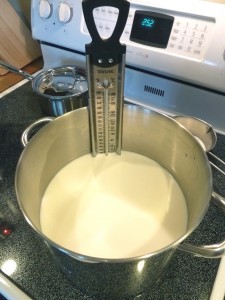
2. If you’re using store-bought pasteurized milk, heat it to 93°F over low heat, stirring frequently, and stir in the calcium chloride.
3. Stir in the diluted lipase powder, if using, and, with the milk at 93°F, sprinkle the culture over top. Stir to combine and cover. Let sit, undisturbed, to ripen for 1 hour. To help keep the milk warm while it’s ripening, especially if you’re making the feta in the winter, set in a sunny spot and/or wrap with a large towel. You may also leave the pot on the turned-off burner on your stovetop, to benefit from the residual heat.
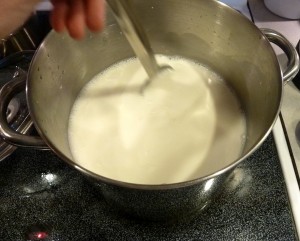
4. Pour in the diluted rennet and stir gently with an up and down motion for one or two minutes to distribute the rennet evenly throughout the milk. (If the milk begins to coagulate while stirring, immediately stop stirring.) Cover and allow to rest at 93°F for 50 minutes to 1 hour. The easiest way to do maintain the correct temperature is to set the pot in a sink of warm water, periodically checking the temperature of the water and adding more hot water as needed to the sink.
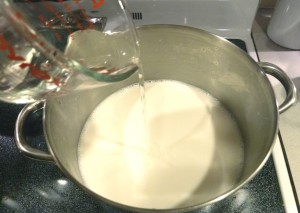
If the rennet did its work, the milk will have separated into a block of curd and whey. If using the feta culture, the curd will appear to be slightly loose and textured rather, unlike the curd formed when using the mesophilic culture, which will appear smooth and uniformly compacted; if using the feta culture, the amount of whey will be greater and, conversely, the block of curd smaller. If you’ve used the feta culture, jump to Step 6.
5. If you’ve used the mesophilic culture, check for a “clean break” in the curd by inserting a clean finger or flat object into it at a 45-degree angle and slowly removing it. The edge of the break should look “clean,” or even, rather than ragged, and the depression will fill with whey. If the edge looks rough or ragged, or the depression fills with milky whey, let sit another 15 to 30 minutes.
6. With a long knife, cut the curds, as evenly as possible, into ½-inch cubes. After making cuts across the curd in one direction, and then another set perpendicular to the first, use your hand to gently lift up and expose the side of the curd block so that you can make lateral cuts to form the cubes. (I think some sort of food-grade wire, or fishing line?, could work to make the lateral cuts, but you’d be working blind. There is a professional cheesemaking tool designed to make lateral cuts to form cubes, but their price is prohibitive for the hobbyist.)
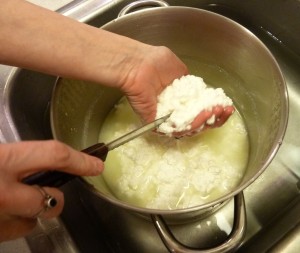
7. Allow to set, undisturbed, for 10 minutes.
8. Using your (freshly washed!) hand and forearm reach into the pot and very gently stir the curds for 20 minutes, while keeping the temperature as close to 93°F as possible. (You could do this in a hot water bath or on the stovetop on the lowest heat, moving the pot on and off the heat as needed.) Use an up-and-down motion while stirring, reaching down into the bottom of the pot and gently bringing the curds upward.

9. Pour the curds into a cheesecloth-lined colander. Gather the ends of the cheesecloth together to form a bundle and hang over a sink or tub. If using goat or ewe’s milk, let hang overnight, or about 8 hours; if using cow’s milk, let hang for 24 hours.
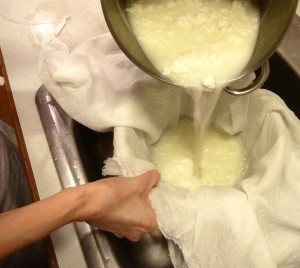
10. Cut the cheese block into large pieces, about 2 to 3 inches in size.
11. Generously salt the pieces on all sides and set on a tray, loosely covered with clean fine-meshed cheesecloth, to drain for two to four days, ideally between 48–56°F. (If using goat or ewe’s milk, two days is about right for the feta culture and three to four days if using the mesophilic culture. If using cow’s milk, salt and drain for four days.) Check for whey accumulation to determine how much longer to salt and drain the whey. Each day, turn the pieces, sprinkle on some additional salt, and, if the cheese isn’t elevated on some sort of rack, be sure to drain off any whey that has accumulated. (According to author Mary Jane Toth, if the cheese sits in whey, it will toughen.) Some sources say to set the salted and draining cheese at room temperature, while others say to put the cheese in the refrigerator to drain. Make a decision as to the best location depending on how many days you will be salting and draining the cheese and the time of year. I set my cheese at room temperature in a cool room and then move them down to the cellar for the remaining days.
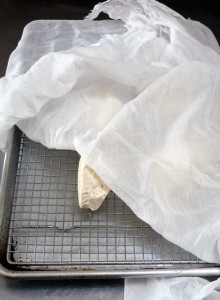
12. Using unchlorinated water, make a 12% salt brine by weight, or 2 ounces (¼ cup) salt for each quart of water. Place the cheese pieces in the brine and, to make sure they are completely submerged in the brine, put some sort of food-safe weight, a saucer, for example, on top of the cheese. As the cheese sits in the brine, the flavor will develop and become stronger, particularly during the first few weeks. Feta will store up to a year, but check it periodically to make sure it isn’t disintegrating in the brine. If so, remove from the brine and eat within two weeks or wrap and freeze. In your next batch, use calcium chloride.
13. This cheese tends to be high in salt. If it is too salty for your taste, soak it for a few hours (or up to a day) in water before using. Once it is desalted, it should be used in a day or two. Serve drizzled with olive oil, a loaf of crusty bread, and wine.
Q & A
Q. Why home pasteurize raw milk?
A. Pasteurizing kills unwanted bacteria, creating a clean slate, as it were, for the bacteria you are introducing and want to flourish—in this case either the feta or mesophilic culture—without competition from pre-existing bacteria.
Q. Why use calcium chloride?
A. Calcium chloride restores calcium, crucial for strong curd formation, which is lost or made unstable during commercial pasteurization and homogenization processes and the long periods of cold storage that store-bought milk undergoes. Unless you’re using store-bought milk, or are having trouble getting a firm set, you probably won’t need to use it. I used a bottle of calcium chloride solution. (It’s also
Q. Why use lipase powder?
A. For the flavor it brings to cheeses. It is naturally found in all milk, including human, and is particularly high in goat’s milk. Lipase breaks down and distributes fat solids in milk, making it easier to digest and, because fat carries flavor, it helps to bring the inherent flavor in milk to the forefront. Lipase powder should be stored in the freezer.
Q. What is in the feta culture?
A. Specially-formulated freeze-dried, direct-set cocktail of mesophilic and themophilic cultures—the two basic classifications of cultures used in cheesemaking—for the manufacture of feta cheese.
The thermophilic culture helps to lower the PH of the curd, allowing it to release more whey, helping to create the classic Feta texture. Store in the freezer.
Q. What is fine cheesecloth?
A. It’s similar to common cheesecloth, but has a much finer weave. The cheesecloth you can find at a grocery store or hardware store is not fine enough. Fine cheesecloth, sometimes called “butter muslin,” can be purchased as cheese supply companies. Alternately, you might try using several layers of cheese cloth—at least four.
Sources
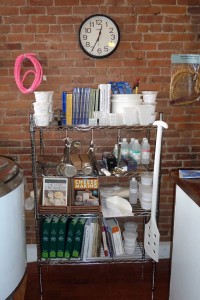
Cheesemaking supplies at Bob-White Systems
For the feta culture, and general cheesemaking supplies:
Bob-White Systems Cheese Making Supply
South Royalton, VT
(802) 763-2777
The Cheesemaker
Cedarburg,WI
(414) 745-5483
For the feta culture:
For general cheesemaking supplies:
New England Cheesemaking Supply Company
Ashfield, MA
(413) 628-3808
Caprine Supply
De Soto, KS
(913) 585-1191
Hoegger Supply Company
Fayetteville, CA
(401) 461-6926
